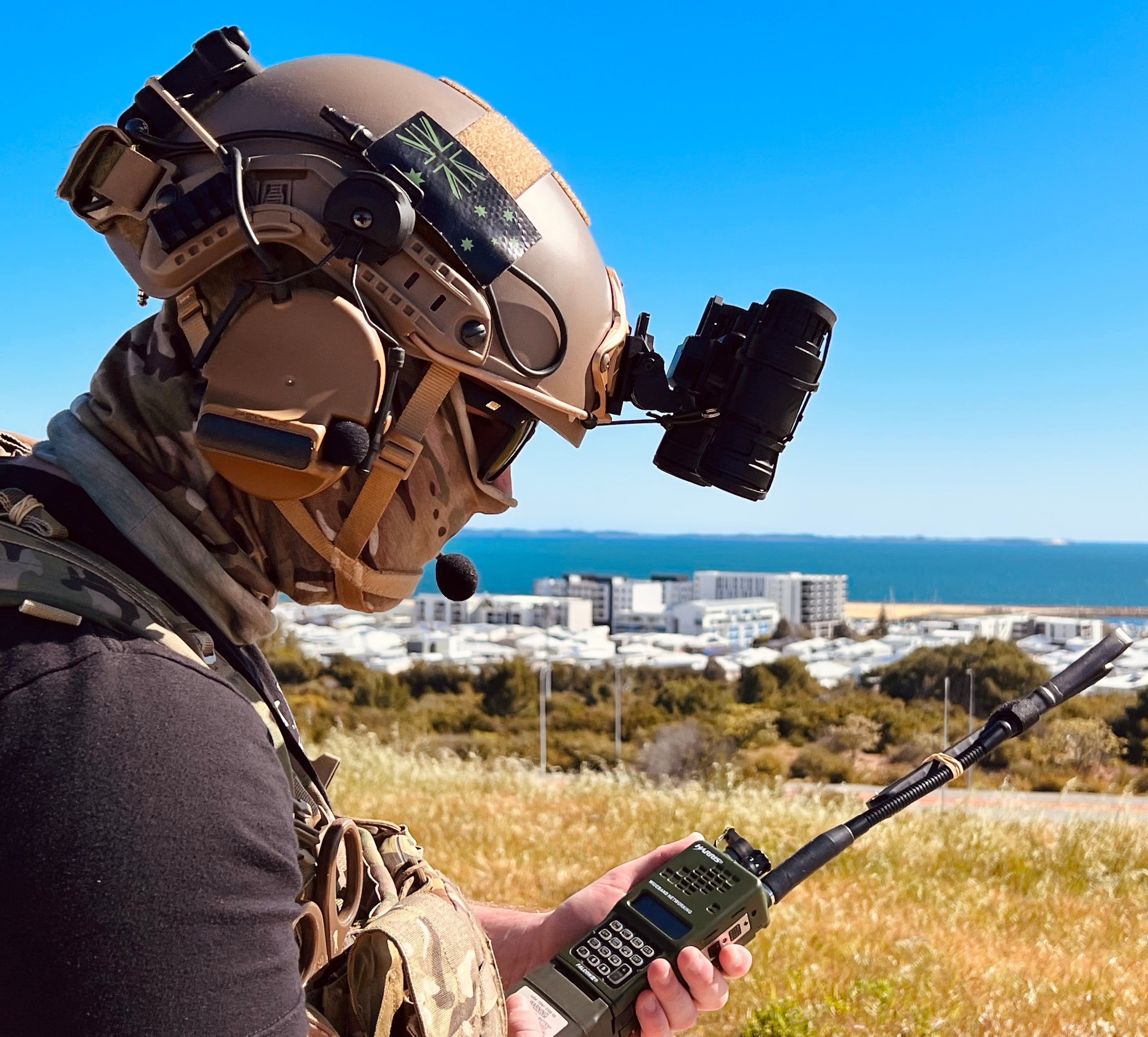When selecting a night vision device—particularly for law enforcement or critical operations—understanding the technical specifications of image intensifier tubes (IITs) is essential. These specifications directly affect how an end-users Night Vision system performs under various lighting conditions in Rural or Urban environments.
Below is a comprehensive overview of the core performance metrics associated with IITs and how they translate into real-world effectiveness.
Image Intensifier Tube (IIT)
The IIT is the heart of any night vision device. It is responsible for capturing low levels of light (such as starlight or moonlight), converting it into electrons, amplifying the signal, and then converting it back into a visible image. A high-quality tube allows for effective vision in environments that would otherwise be nearly pitch black to the Human eye.
Figure of Merit (FOM)
FOM is a broad performance metric used to gauge the general effectiveness of an intensifier tube. It is calculated as:
FOM = Signal-to-Noise Ratio × Resolution
While FOM is a useful benchmark, it should not be used in isolation. Two tubes with the same FOM may offer dramatically different real-world performance depending on their individual SNR, resolution, EBI, and gain characteristics.
Resolution (lp/mm)
Resolution refers to the tube’s ability to distinguish fine details in the image. It is measured in line pairs per millimeter (lp/mm).
-
Higher resolution = sharper, more detailed image with a better ability to resolve smaller details.
-
Optimum Performance Threshold: ≥ 57-60 lp/mm
-
High-performance systems: 64–72+ lp/mm
Signal-to-Noise Ratio (SNR)
Signal-to-Noise Ratio (SNR) expresses the ratio of true signal (light detected by the photocathode) to background noise (random electronic noise). SNR is a useful metric to reflect image clarity in low-light conditions.
A higher SNR indicates a cleaner, more detailed image with minimal grain or distortion.
-
Critical for higher image performance in starlight and no-moon conditions.
-
Optimum Performance Threshold: ≥ 23-25
-
Exceptional performance: 30–33+

(Example of an NVT4 1400+FOM White Phosphor Tube which has an SNR value of 23.59. This results in a noisier, grainier image when present in lower lighting conditions.)
Photocathode Sensitivity
Photocathode sensitivity indicates how efficiently the tube converts light to electrons. It is a key measure of how the system performs in very low-light scenarios. Photocathode Sensitivity is measured in microamperes per lumen (µA/lm).
- Optimum Performance Threshold: 700-1200 µA/lm @2856K
-
High Performance Threshold: ≥ 1800–2000 µA/lm @2856K
-
Higher sensitivity = improved image brightness and contrast.
Equivalent Background Illumination (EBI)
The inherent background brightness of a night vision device when no light falls on the photocathode. Expressed in lumens per square centimeter (lm/cm²), lower EBI indicates a more sensitive device capable of detecting fainter light sources.
EBI quantifies the amount of noise (or glow) generated by the tube when no external light is present.
-
A low EBI ensures better image quality in complete darkness.
-
Optimum Performance Threshold: ≤ 0.25 µlx
Halo (mm)
Halo is the blooming effect seen around bright light sources (e.g., street lamps) in night vision imagery.
-
Smaller halo = better clarity and target identification near light sources.
-
Optimum Performance Threshold: < 0.7 mm

System Gain (Also Referred To As Luminance Gain)
Describes the increase in brightness between the input and output of an image intensifier tube. Gain rises as ambient light decreases and is expressed in either:
- Foot-lamberts per foot-candle (fL/fc), commonly used in the U.S.
- Candela per square meter per lux (cd/m²/lx), commonly used in Europe and Asia.
Gain is used to describe the amplification of light within the intensifier tube. It directly affects image brightness in lower light conditions and contrast.
-
Optimal Operational range: 8,000–10,000+ cd/m²/lx
- High Performance Operational Range (Generation 2): 11,000-15000+ cd/m²/lx
-
Gain should be balanced to prevent washout and maximize image sharpness.
Autogain / Automatic Brightness Control (ABC)
Autogain protects the tube from sudden light exposure and adjusts image brightness automatically in changing environments. It is a critical feature for field use in dynamic lighting conditions.
Manual Gain / External Gain Adjustment Circuit (EGAC)
Some image intensifier tubes support manual gain adjustment via a 3-pad (MX-10160 format) or MX11769 EGAC configuration, enabling users to adjust brightness in varying conditions by managing voltage resistance using a Linear Potentiometer within specific night vision housings. Even in such systems, automatic brightness control remains active for safety and tube protection.
Phosphor Types (P43 / P45)
The visible image produced by Night vision technology relies on phosphor coating within the Phosphor Screen, which emits light when exposed to radiant energy like electrons in Night Vision Image Intensifier Tubes.
The phosphor screen converts electrons into visible light for enhanced visibility in low-light conditions.
-
P43 (Green Phosphor): Conventional phosphor type with extended viewing comfort and reduced eye fatigue. Green Phosphor was heavily utilized in Military Night Vision systems due to human eye's heightened sensitivity to green light, minimizing discomfort for prolonged use.

-
P45 (White Phosphor): Enhances target detail and contrast. The Phosphor coating improves contrast sensitivity and object identification compared to traditional counterparts with green phosphor tubes. White Phosphor delivers more authentic nighttime imagery, mimicking natural grayscale scenes.

Diopter Adjustment
Allows users to fine-tune focus based on individual eyesight. Most systems accommodate a range of +2 to -6 diopters.
Collimation
Collimation aligns the two optical axes of each pod straight in three-dimensional space. Improperly collimated goggles force the eyes and brain to correct misalignment, leading to a significant level of additional fatigue when compared to properly calibrated goggles.
Nocturnal Optics Australia conducts optical alignment with precision using a custom CNC manufactured Collimation Rig which has been carefully designed and assembled specifically for our needs. This system allows us to accurately collimate and bore-sight both binocular and monocular night vision systems to exacting specifications, ensuring perfect optical convergence and optimal user experience in the field.

Nitrogen Purging & Leak Testing
All modern housings undergo nitrogen purging to eliminate moisture and protect internal components. Leak testing confirms the seal’s integrity, preventing internal fogging and extending the system’s lifespan.
Nocturnal Optics Australia performs Night Vision system nitrogen purging and leak testing using a Litton Electrical analog purge and leak detection system — a proven industry-standard tool that verifies the internal environment is vacuum sealed against moisture, particles and other contaminants by displacing the contaminated Oxygen with concentrated Nitrogen Gas.

Generational Technologies:
-
Gen II: Introduced in the late 1970s, Gen II tubes improved upon earlier technologies with better photocathodes and MCPs. Still used in civilian and budget systems.
-
Gen III: Introduced in the 1980s, Gen III tubes employ gallium arsenide photocathodes and deliver superior performance in low-light and military-grade applications. The latest evolution of Gen III Thin-Filmed and Filmless, offers increased sensitivity and reduced halo through the removal of the ion barrier.
Conclusion
Selecting the right night vision system requires more than just picking the highest FOM. True performance comes from a holistic balance of resolution, SNR, sensitivity, EBI, and overall system gain. By understanding these specifications and how they affect real-world use, users can make informed decisions and achieve superior results in the field.
Want to learn more? Follow Nocturnal Optics Australia on our website and social media for further insights, product updates, and educational content on night vision and thermal imaging systems.



